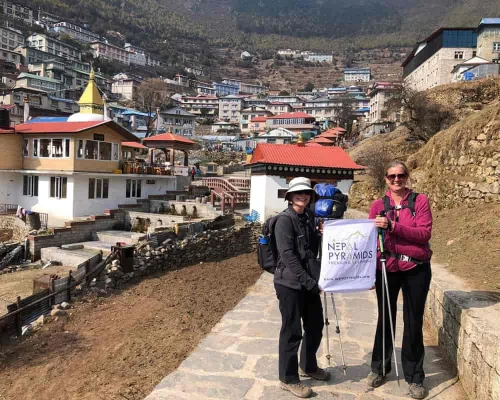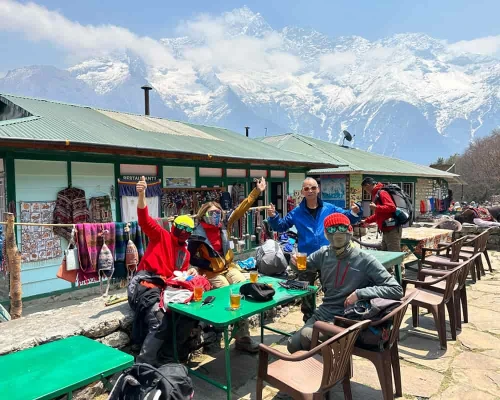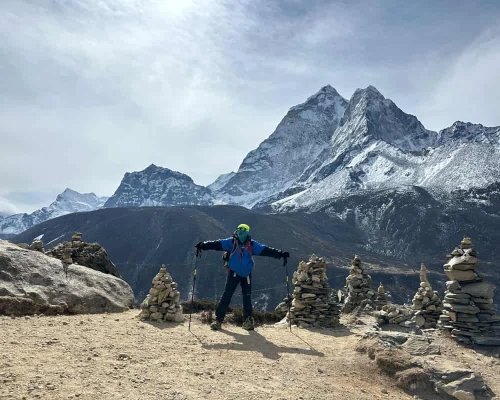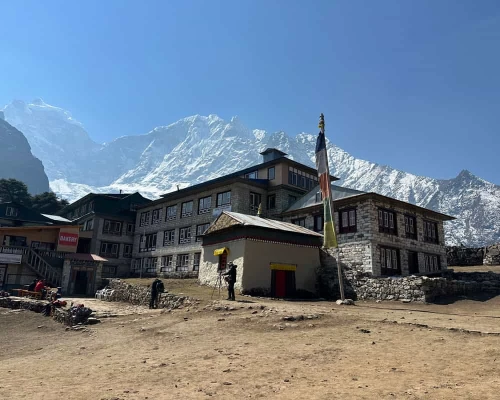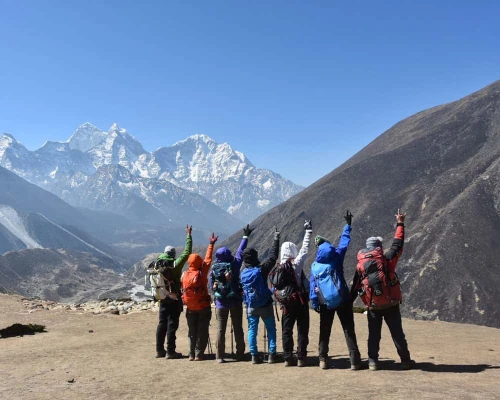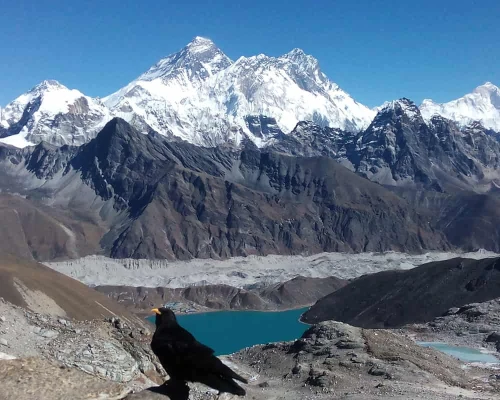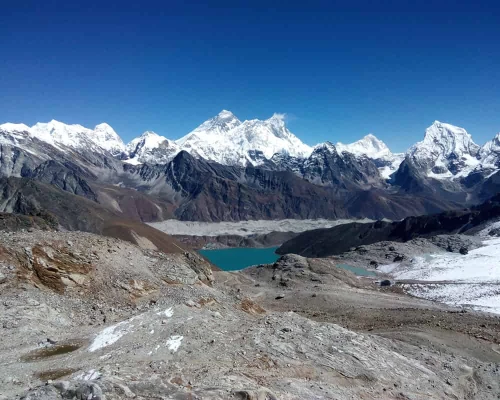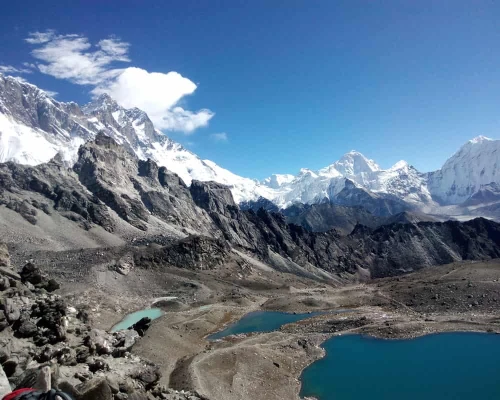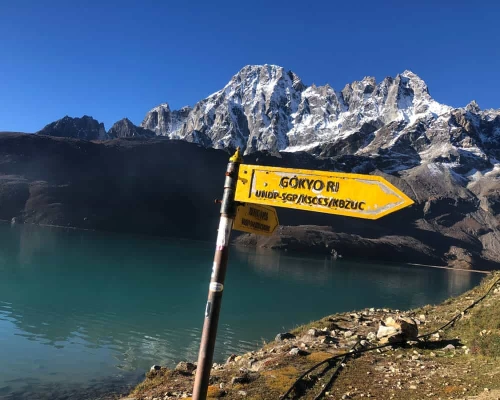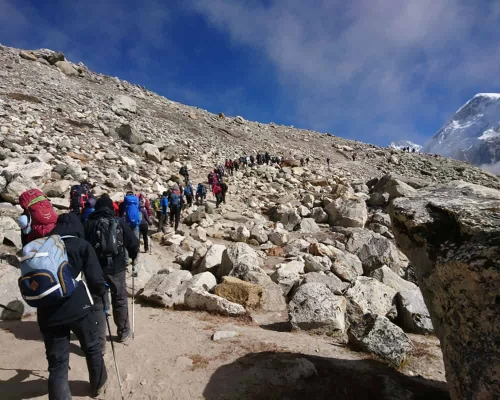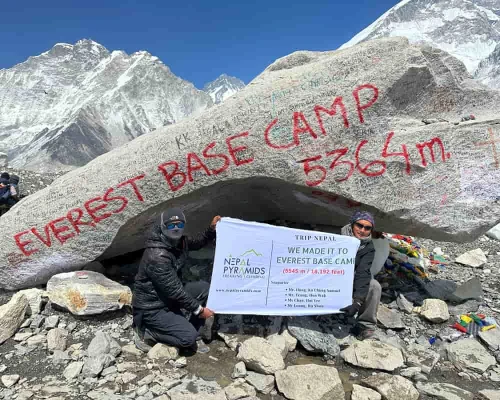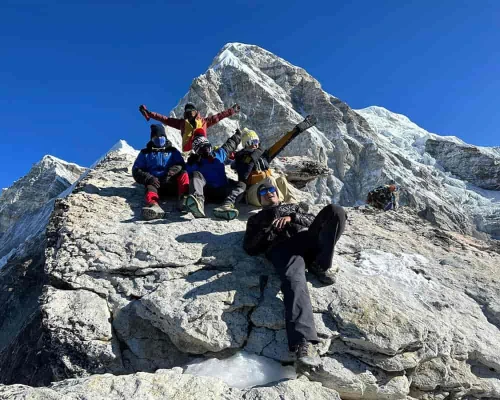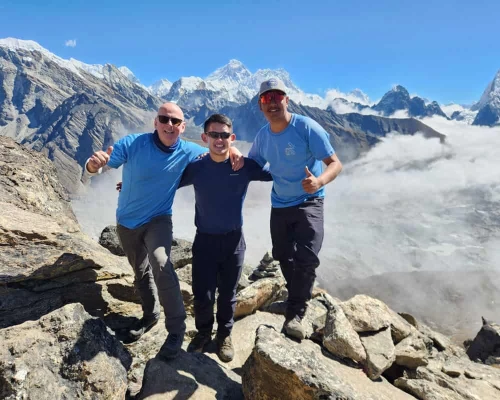Everest 3 High Passes Trek Highlights
- Scenic but heart-pounding flight to the world's most thrilling airport of Lukla.
- Get ready to land on the shortest inclined airstrip in a small mountain plain.
- Trek through enchanting Sherpa villages offering you their Tibetan-style traditions.
- Witness the diverse beauty of Everest going through 3 different valleys of Thame, Gokyo, and Everest Base Camp.
- Conquer the most scenic mountain pass of Renjo-La with jaw-dropping panoramas
- Discover the hidden gem of Gokyo's turquoise lakes
- Cross the mighty Ngozumpa Glacier, the longest glacier in the Himalayas (36 km).
- Going over the incredible Cho-La Pass, the icy glacier mountain pass.
- Hike to the iconic Everest Base Camp @ 5,360m.
- Stand atop Kala Patthar @5,545m for an unforgettable Everest view
- Cross the pristine Kongma La and explore the remote valleys untouched by the modern world.
- Experience the raw beauty of the Himalayas and conclude your trek with a scenic flight back to Kathmandu.
Everest 3 High Passes Trek Overview:
Everest 3 High Passes Trek concludes
- Renjo La Pass (5,360 m/17,585 feet),
- Cho La Pass (5,420 m/17,782 feet), and
- Kongma La Pass (5,535 m/18,159 feet)
Everest 3 High Passes Trek is a strenuous plus trek intended for those who are seeking challenges to test their physical and mental endurance. This 18-day expedition through 3 distinct high passes, Renjo La Pass (5,360 m/17,585 feet), Cho La Pass (5,420 m/17,782 feet), and Kongma La Pass (5,535 m/18,159 feet) is more of a secretive trek.
It takes you to the pristine valleys through off-the-beaten-track which are purely raw and tranquil. These secret valleys are away from the overcrowded tourism like in the regular traditional trails of Everest.
This challenging trek takes you to three different Valleys of Thame, Gokyo, and Everest Base Camp. Each of these valleys has its own unique features and beauty. Thame Valley gives you the history of the earliest settlement of the Sherpa people who migrated from Tibet via the Nangpa La Pass. Gokyo Valley takes you to a hidden Himalayan gem with stunning turquoise lakes and gives you the spiritual significance of the region. Finally, Everest Base Camp Valley gives you the history of human quest and conquest over these majestic mountains.
Going over these high-altitude passes is undeniably very challenging but very worthwhile. Furthermore, the conquest of being at the top of them is very appealing with a great sense of accomplishment. Its exceptional views and magical beauty can't be denied. Moreover, going over these submissive high passes gives you more of a chance to know, understand, believe, and trust yourself.
Everest 3 High Passes Trek Trip Information:
Everest 3 High Passes Trek is unquestionably an ideal pick for a true adventure seeker who is in the quest for a genuine undertaking. After flying into Lukla, the world’s most thrilling airport we enter the Sagarmatha National Park buffer zone. Our first-day trek will be through the delightful Dudh Koshi Gorge trail towards our first destination of Phakding.
After Phakding crossing the ample suspension bridges including the highest Edmund Hillary Bridge we will get to Namche Bazaar. Soon we leave the traditional EBC trail and take the less-trodden, enchanting valley to the west towards the beautiful settlement of Thame. Thame village was under the disastrous 2024 GLOF (glacial lake outburst flood) that has taken half the village. You will witness the effects of this tragic GLOF when you get there.
Thame is the valley where it is believed that the first Sherpas settled here after migrating from Tibet. Besides, for decades this town was a junction for trade between the locals and Tibetan traders who came over the Nangpa La Pass. Gradually we will conquer the most scenic Renjo La Pass which offers the best view of Everest and the most exquisite sight of the mountain panorama.
It is remarkable being at Gokyo with its turquoise Lakes and exceptional beauty. It is certainly very overwhelming to cross the Ngozumpa Glacier, the longest glacier in the Himalayas.
Additionally, going over Cho La Pass, the icy glacial mountain pass is incredible. We will stay in the alpine settlements of Dragnak, Dzongla, and Lobuch which is certainly a genuine wilderness experience. Leaving Lobuche we will further proceed towards Gorak Shep and hike to the iconic Everest Base Camp.
Being at Everest base camp is absolutely out of the ordinary. It is certainly amazing to be at a place where mountaineers from around the world gather here with the same vision and same quest.
Winning the final Kongma La Pass with a grandiose view of Island Peak and Lhotse is exceptional. Shortly after we will walk back via a different section of Everest now with a visit to the spiritual Tenboche Monastery. Eventually, we will retrace our trail back to Lukla with a great sense of achievement.
We will conclude our trek with a scenic mountain flight to Kathmandu that offers you the final incredible mountain view.
Renjo La Pass @ 5,360 m/17,585 feet
Renjo La is one of the most outstanding mountain Pass that unfold before you the enchanting valleys of Everest. This beautiful mountain Pass stands at an elevation of 5,360 m/17,585 feet. The path leading to Renjo La is a rugged mountain terrain giving you the genuine trekking experience.
As you ascend the pass, no matter which way you choose to climb, you will be rewarded with panoramic mountain views. Travelers will be fascinated by the best view of Mount Everest, better than from Kala Patthar. Besides Everest, you will see the neighboring peaks, such as Lhotse, Nuptse, Cho Oyu, Makalu, and many more.
The beauty of Renjo La Pass is not just limited to its magnificent vistas. The pass serves as a passage leading you to the magical valleys of Everest. It serves as a bridge between the two different magnificent valleys of Gokyo and Thame.
Cho La Pass @ 5,420 m/17,782 feet
The second pass, Cho La, sits at an altitude of 5,420m / 17,782 feet and presents a thrilling challenge to trekkers. This icy pass is an active glacier that changes its routes every year due to the glacier movement. It is certainly a thrilling experience to go over the icy Cho La Pass. Mini crampons or spikes (Yaktrax) is highly recommended for this glacial mountain pass.
The pass is known for its steep and rocky terrain, which requires careful navigation and endurance. Besides Yaktrax, walking poles will be of additional help especially walking down to Dzongla.
However, the effort is well worth it as you reach the top and find yourself surrounded by the majesty of Ama Dablam, Cholatse, and other awe-inspiring peaks. The view of Cholatse Lake below adds a touch of beauty creating a truly magical atmosphere.
Kongma La Pass @ 5,535 m/18,159 feet
The final pass, Kongma La, stands at a formidable height of 5,535m / 18,159 feet. From Lobchu you will cross the iconic Khumbu Glacier and climb the initial vertical trail to get to the ridge. Gradually we will make our way through the rugged beauty of the mountain terrain into the untouched hidden valley.
Kongma La Pass is quite challenging and technical as compared to the other two mountain passes. This pass is rarely trekked by the trekkers so you will be away from the overcrowded Everest trail. As you walk you will discover absolute serenity with towering peaks rising in every direction. The sense of accomplishment after completing the Kongma La is indescribable.
The expansive views of the Glacier, Lhotse, Makalu, Imja Valley, and the surrounding peaks is magical. After a long day demanding hike, you will get to Chhukung which would seem like a mirage in the remoteness of the mountains.
Beyond these high mountain passes, the Everest Three High Passes trek also offers a great opportunity to understand the culture of the Sherpas. You will witness ample stories, legends, and world records regarding the conquest of high mountains by this tribe over the years.
The beauty of doing this Epic Trek lies not only in the breathtaking landscapes but also in the personal achievement. Furthermore, this trip combines the thrill of adventure with the unimaginable beauty of the Himalayas. It is an experience that will be remembered for a lifetime.
Find more details on the Blog Post: 10 Reasons Why You Should Do Everest High Passes Trek.
Likewise, you may also like:
Everest 3 High Passes Trek Anticlockwise, Everest Two High Passes Trek, and Everest High Passes and Island Peak.


